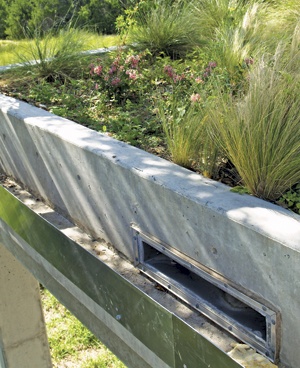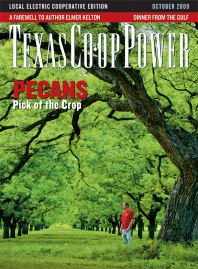A new kind of sodbuster is taking root in Texas, akin to the original ones of the 1800s who moved west, built houses of sod and began plowing the soil on their newly claimed farmland.
Today’s homebuilding sodbusters are constructing roofs with soil and vegetation as a way to reduce their carbon footprint and conserve energy. Just as sod houses on the prairie stayed cool in the summer and warm in the winter, modern sod-roof and vegetated-roof houses provide a similar weather-shielding effect. They can help lower air-conditioning costs and reduce the peak demand on area power plants.
Kathy Zarsky, founder and president of HOLOS Collaborative, an Austin-based sustainability management company that helps clients build environmentally responsible and resource-efficient structures, is one such homeowner in the Austin area. A winding drive through fields of yucca, wildflowers and sumac, juniper and live oak trees leads to her home. The wild Texas landscape continues across part of her rooftop, where native plants jut up from the roofline.
From the entry to her home at the base of a large, round limestone tower, she climbs a winding stairwell to a door on the second floor and steps out onto her garden roof. There, a small patio of limestone pavers is surrounded by a garden of native, drought-hardy plants, including agave, Mexican feather grass, spineless prickly pear and a small patch of dwarf thyme. Her rugged rooftop plants blend with the Hill Country vista to the south.
Zarsky, a Pedernales Electric Cooperative member who obtained an architecture degree from the University of Texas in 1994, advocates the benefits of green, vegetated and sod roofs. The sustainability consultant explains the three terms:
Green roof—A broad term referring to any environmentally beneficial roof that typically is covered with vegetation and makes a structure more energy efficient. But green roofs—which don’t necessarily involve plants or anything the color green—can also feature such green technology as solar panels.
Vegetated roof—Synonymous with the term “garden roof,” this is a type of green roof covered with a soil mixture and a variety of plants.
Sod roof—A type of green roof that incorporates soil and grass.
Zarsky and her husband, Jon, began building their Austin-area house seven years ago with a vegetated roof incorporated into the design. The garden roof is above the living room and occupies about one-third of the home’s total roof area.
Garden roofs, though not widespread, are of increasing interest, she said, noting at least eight finished commercial garden-roof projects in the Austin area, at least that many finished residential ones and many more currently under design.
Building a green roof was a simple decision for the Zarskys. “We wanted to be water-conserving and replace a portion of landscape we disturbed when we built the house,” she said.
They were also inspired by other benefits of a well-designed garden roof:
• A quality garden roof of native plants requires minimal maintenance and only needs watering when plants are getting established or are stressed.
• A vegetated roof has a lower surface temperature than other roof types, thus reducing both electricity bills and the heat-island effect created in cities when buildings, concrete and asphalt absorb heat from the sun, thus making the area hotter.
• Because a good soil mixture contains water-retaining elements, water runs off more slowly and the surrounding land has more time to absorb it, reducing storm-water runoff.
• Water running off a garden roof that does not use fertilizers, herbicides or pesticides is cleaner than that coming off of a conventional roof, which improves the quality of storm-water runoff.
• A garden roof provides natural habitat.
Garden Roof Ingredients
Though the Zarskys chose a multilayered garden roof system, there are other and simpler ways to design a vegetated roof, Kathy Zarsky said.
“Our philosophy is we want to be low maintenance,” she said, explaining that they opted for native plants that can take care of themselves. “We’re trying to replicate natural systems and just let them do their thing as much as they can.”
Natives are preferable because they are adapted to the heat and water cycles in the climates where they’re found, but roof plants have a shallower area for their roots, so not all natives will do as well on the roof as on the ground, Zarsky said.
Her roof sits in a rubberized asphalt membrane that functions like a bathtub. The membrane is covered by several layers, including root-barrier and filter fabrics, insulation, a moisture-retention mat, drainage trays and sheets and a soil mixture 6 inches deep.
A vegetated roof must support foot traffic and generally weighs more than a conventional roof because of soil, vegetation and rain saturation, so it needs a strong supporting structure. Zarsky’s garden roof weighs about 31 pounds per square foot. It looks flat but is slanted slightly down toward the edge to allow drainage.
An existing house could be retrofitted to accommodate a garden roof but only after several questions are answered, such as how much weight the house’s roof can bear, she said. Another major structural consideration is whether a vegetated roof will leak. With proper installation, it probably won’t, she said.
Zarsky and her family have appreciated the multiple benefits of their garden roof.
“It has exceeded every expectation we had,” she said. “The plants have all thrived, and it’s a very enjoyable place for us to visit.”
——————–
Staci Semrad is an Austin-based freelance writer.


